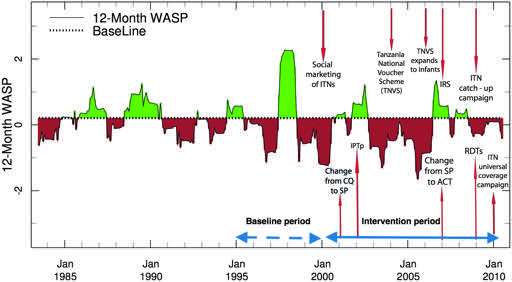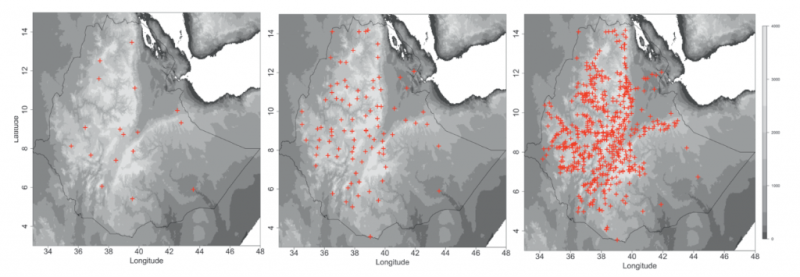Seasonal changes in climate may muddle results of malaria interventions in Africa

New studies released today in a special supplement of the American Journal of Tropical Medicine and Hygiene add to the evidence that over the last decade, global malaria control efforts have saved millions of children's lives in areas most affected by malaria.
Some of the studies, including one conducted by the International Research Institute for Climate and Society (IRI), present new methods for evaluating large-scale malaria control programs.
Malaria remains a major cause of preventable death, killing an estimated 429,000 people and causing more than 212 million illnesses in 2015, according to the World Health Organization. Hundreds of millions of people have benefited from protective measures, such as insecticide treated bednets and spraying of homes with insecticides, and have been appropriately diagnosed with rapid diagnostic tests and treated with effective anti-malarial drugs.
The September 2017 supplement includes nine novel contributions on evaluating the impact of malaria control interventions in sub-Saharan African countries, where the majority of malaria deaths are among children under the age of five years.
The IRI-led study assesses the likely impact that changes in climate have on the assessment of the effectiveness of national malaria interventions in ten of these countries.
"Malaria is a climate-sensitive disease, meaning that natural fluctuations in rainfall and temperature conditions from one season or one year to the next can have a significant impact on the suitability for transmission of the disease," said IRI's Madeleine Thomson, who led the research.
"The mosquito that carries the parasite that causes malaria flourishes in the tropics," said Julie Wallace, who is the head of the malaria division at the U.S. Agency for International Development's Global Health Bureau. "Warm temperatures, rainfall and humidity determine the geographical distribution, seasonality and prevalence of the disease."
"It is important for the President's Malaria Initiative to ensure that when we evaluate the impact of country malaria control activities, we consider climate in our analysis to make certain that all aspects that influence malaria prevalence are considered," said Wallace.
Thomson and her colleagues found that out of the ten countries they examined, three—Tanzania, Zanzibar and Uganda—may be overestimating the impact of malaria control efforts. Unusually wet conditions during the baseline (or control) period and droughts during the intervention period may have contributed towards the observed malaria decline. In general, wet conditions increase the likelihood of standing water and higher humidities, which leads to upticks in mosquito populations that transmit the disease.
In contrast, the researchers found that Mali, Senegal and Ethiopia may be underestimating the impact of their control efforts. In these countries, the intervention periods faced wetter conditions than the baseline periods.

In the remaining four countries–Rwanda, Malawi, Mozambique, and Angola—Thomson and her colleagues could find no strong difference in climate conditions between the pre- and post-intervention period.
The United States contributes to effective malaria prevention and control for over half a billion people from the Sahel to the Horn to Southern Africa. Between 2000 and 2015, malaria deaths declined by 60 percent, and almost 7 million lives were saved. Many children are alive because of work to scale up proven malaria interventions. The reports presented here provide further evidence of the impact that has occurred in many African countries.
"This supplement is the first published collection of impact evaluation papers designed by the interagency team with PMI and implemented in partnership with national malaria control programs and country partners," said Irene Koek, Acting U.S. Global Malaria Coordinator. "The U.S. purposefully and systematically invested in rigorous, scientific country malaria program evaluation to document the impact of malaria control investments."
The authors present real-world evidence of declining trends in malaria infection and illness and improved child survival across sub-Saharan Africa. Further, the studies present new methods for evaluating the impact of large-scale malaria control programs in resource-poor settings with simultaneous scale-up of other maternal and child health interventions.
"The progress we've seen in malaria-endemic countries is inspiring and shows us the impact of our global malaria control programs and investments," said CDC Director Brenda Fitzgerald. "Conducting evaluations like these is critical to inform us of what is working and how we can save more lives from this preventable disease."
Taken together, the articles in the supplement represent a conceptual and practical framework for planning and executing impact evaluations for malaria. The framework builds on previous impact evaluation models and offer lessons for evaluating the impact of control programs for other health conditions in challenging settings.
The papers in this supplement and the accompanying editorial and commentaries all indicate the need to strengthen national capacity for generating strategic information through improved routine health information systems for program monitoring and malaria surveillance.
For the IRI led study, a significant new development that supported the results is the availability of much higher quality climate data through the Enhancing National Climate Services Initiative.
"Working directly with national meteorological agencies we are able to significantly improve the quality of the rainfall and temperature data available to the national malaria control programs," said Thomson.
The articles also identify critical considerations for ensuring strong, informative evaluations, including country ownership, engagement of stakeholders, tailoring evaluations to each setting, and using standard methodology. As comprehensive malaria control strategies continue to make inroads along the continuum from malaria control to elimination, approaches to pursuing impact evaluation will also need to evolve. Malaria deaths will not indefinitely decline in countries that have successfully controlled this disease, and a shift to tracking malaria infection and illness rates will be necessary to guide programs toward elimination.
From the tremendous accomplishments documented in these papers, global malaria partners are challenged to continue refining their approaches based on responding to the best possible data with minimal delay—anticipating that, as Dr. Richard Cibulskis from WHO states: "…enhanced use of information can itself act as a powerful intervention and…further accelerate declines in malaria."
More information: Madeleine C. Thomson et al. Using Rainfall and Temperature Data in the Evaluation of National Malaria Control Programs in Africa, The American Journal of Tropical Medicine and Hygiene (2017). DOI: 10.4269/ajtmh.16-0696
This story is republished courtesy of Earth Institute, Columbia University http://blogs.ei.columbia.edu.

















